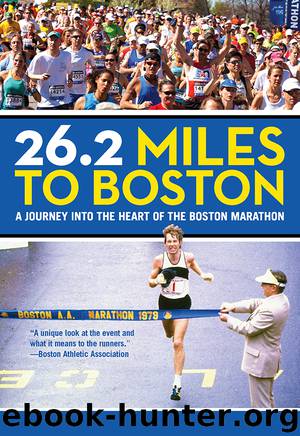26.2 Miles to Boston by Michael Connelly

Author:Michael Connelly
Language: eng
Format: epub
Publisher: Lyons Press
Published: 2014-03-17T16:00:00+00:00
Lead runners make their way through the end of Wellesley Center with attendants accompanying them on bicycles. © Running Past
The motivation to continue to run can be found within the original decision that compelled the runner to first start running. Because in that first instance, when the desire first bubbled to the surface, the runner saw the world with their legs and not just their eyes.
“Why run?” is not just a question for the doubting amateur; the elite must ask it as well. The two greatest champions in the history of the race, Clarence DeMar and Bill Rodgers, nurtured their craft of running because of something more elemental: They had to get to work somehow. Rodgers grew up running, but returned to his gift when his motorcycle was stolen and he had no other way to get to his job. While DeMar and Rodgers ran to their places of work, Alberto Mejia of Colombia ran after losing his job as a metalworker. After getting laid off, he had nothing else to do, so he trained with laser focus in the weeks leading up to his 1971 Boston championship.
Others run because they are physically required to do so. Quite literally, they run to live—or to live the way they want to. Gayle Barron, winner of the 1979 race, had only been running for ten years when she captured the championship. The only reason she started to run was that she liked to eat, and couldn’t continue as a newscaster if she didn’t find a way to neutralize the calories. While Barron ran to maintain her physical status for her job, Elijah Lagat of Kenya had to lose weight to live. He had never been interested in running until at age twenty-five, his doctor told him he had to lose twenty-five pounds or die. He ran, and won the 2000 race.
Others use running as a catalyst to save their spiritual and emotional being. For some, running can be an outlet that separates them from the mental traps that restrict—and sometimes paralyze—their lives. Back in the 1970s, chain-smoking Patti Catalano decided to turn her life around while sitting in a drinking establishment where she had turned to escape the shackles of a harmful family life. It was in running that she felt free—that she found purpose and direction. Catalano would go on to become one of the greatest American female runners in history. She won the Honolulu Marathon three times, finished second in Boston three times, and set American records in almost every running discipline—including the marathon.
The commitment to reverse the course of one’s life is a process that requires muscles besides those found in one’s legs. The stagnant have to flex the muscle of the soul. In 1989, New Zealand runner John Campbell confessed that he had lost his way. Depressed over failed business ventures and a crumbling marriage, he realized that his life was in flux. “My life was in shambles; I was going nowhere,” he admitted. Campbell turned his attention back to running with a renewed focus.
Download
This site does not store any files on its server. We only index and link to content provided by other sites. Please contact the content providers to delete copyright contents if any and email us, we'll remove relevant links or contents immediately.
Shoe Dog by Phil Knight(5141)
The Rules Do Not Apply by Ariel Levy(4861)
Walking by Henry David Thoreau(3893)
How to Read Water: Clues and Patterns from Puddles to the Sea (Natural Navigation) by Tristan Gooley(3407)
Running Barefoot by Amy Harmon(3397)
I'll Give You the Sun by Jandy Nelson(3358)
Crazy Is My Superpower by A.J. Mendez Brooks(3329)
How to Read Nature by Tristan Gooley(3249)
How Music Works by David Byrne(3187)
The Boy, the Mole, the Fox and the Horse by Charlie Mackesy(3000)
The Fight by Norman Mailer(2848)
Seducing Cinderella by Gina L. Maxwell(2604)
Cuba by Lonely Planet(2577)
Accepted by Pat Patterson(2302)
Going Long by Editors of Runner's World(2295)
The Unfettered Mind: Writings from a Zen Master to a Master Swordsman by Takuan Soho(2249)
The Happy Runner by David Roche(2194)
Backpacker the Complete Guide to Backpacking by Backpacker Magazine(2193)
Trail Magic by Trevelyan Quest Edwards & Hazel Edwards(2125)
